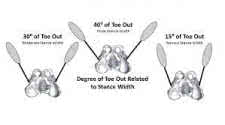Wide or Narrow Squat Stance - Electromyography Study on Proper Stance

Get the most out of your leg training with proper stances
There's been very little actual research in the area of strength training and bodybuilding. Consequently, much of the so-called
knowledge put forth by self-proclaimed experts in the industry is primarily the product of trial and error, scientifically void
experiments and the passing on of beliefs from one generation to the next. It's precisely this tradition in the sport-and the
lack of scientific information-that has created, validated and perpetuated a number of bodybuilding myths.
One such myth involves the notion that different squatting stances can isolate and develop different areas of the quadriceps
muscle. Proponents of this theory claim that squatting with a close stance will better enhance the development of the vastus
lateralis, or outer thigh, while using a wide stance will have a greater effect on vastus medialis, or inner-thigh, development.
We set out to determine, through scientific analysis, whether there was any truth to this claim.
THE STUDY
We asked subjects to squat using both wide and narrow stances while we recorded electromyographic, or EMG, measurements from both the vastus medialis and vastus lateralis. We recruited six volunteer athletes-three men and three women-who were healthy and free of neuromuscular disease. MI had at least two years' experience in strength training and had never practiced performance doping.We tested on two separate days. On the first day we determined each subject's one-rep-maximum weight, or 1RM, for both exercises. The athletes did a warmup of four reps at 50 percent of 1RM, three reps at 80 percent and two reps at 90 percent, with five-minute rest intervals between the sets. They then performed three 1RM efforts, again with five-minute rest intervals. On the second day the subjects did 80 percent of 1RM five times, taking three-minute rests.
All lifts were performed with the Safety Squat Bar. For wide-stance squats the subjects' feet were 311/2 inches apart; for narrow-stance movements they were shoulder width apart.
All EMG data was rectified and integrated for one second; this is known as IEMG. The stance that yielded the highest IEMG at 1RM for each muscle, based on the average of the three 1RMs for each stance, was designated IEMG max. IEMG values from the 80 percent efforts were expressed as a percentage of IEMG max for two muscles, based on the average of the five trials.
THE RESULTS
Our data indicated that there was no significant main effect for the muscles in question. The EMG analysis showed that the percentages of IEMG max for the vastus medialis wide stance and close stance were not significantly different at 75.3 and 73.8, respectively; and those for the vastus lateralis wide stance and close stance, at 75.8 and 78.4, were also not dramatically.Therefore, the results of this study do not support the claim that you can specifically target the vastus medialis or lateralis by altering your squatting stance.
DISCUSSION & CONCLUSION
The slightly greater amount of muscular activation for the vastus medialis with a wide stance does not result in a significant difference in the muscle's development. The same is true for the slightly greater muscular activation measured on the vastus lateralis during the wide-stance squat.The results documented by the EMG recordings for this study shouldn't surprise those who have a background in anatomy or physiology. Because the parts of the quadriceps share a common tendon of insertion at the knee joint, it's unlikely you'll succeed in developing one area of the muscle over another.
If you're wondering what type of stance you should be using for squats, the answer is simple: the one that's the most comfortable for you. If you're comfortable with the squatting stance and position, you should be able to lift more weight with greater safety. The bottom line is, bodybuilders and weightlifters get greater strength and mass gains when they use proper techniques, a comfortable stance, a proper squat bar, such as the Safety Squat Bar and a healthy positive mind-set.